MPA702 Assignment 1: Financial Statements and Analysis of Park Health
VerifiedAdded on 2023/06/10
|8
|1352
|322
Homework Assignment
AI Summary
This assignment solution for MPA702, focuses on the financial analysis of a health policy and research consultant business, Park Health, owned by Grace Park. The assignment requires students to analyze transactions, create a transaction analysis chart, prepare an income statement and a statement of financial position. It includes recording transactions such as investment of funds, purchase of assets, and revenue generation. Part C of the assignment addresses the business structure, discussing the implications of unlimited liability for a sole proprietorship and recommending the formation of a Limited Liability Company (LLC) to minimize risk. The solution highlights the tax benefits and potential liabilities associated with an LLC, including instances where the corporate veil can be lifted. The document includes references to relevant academic sources.
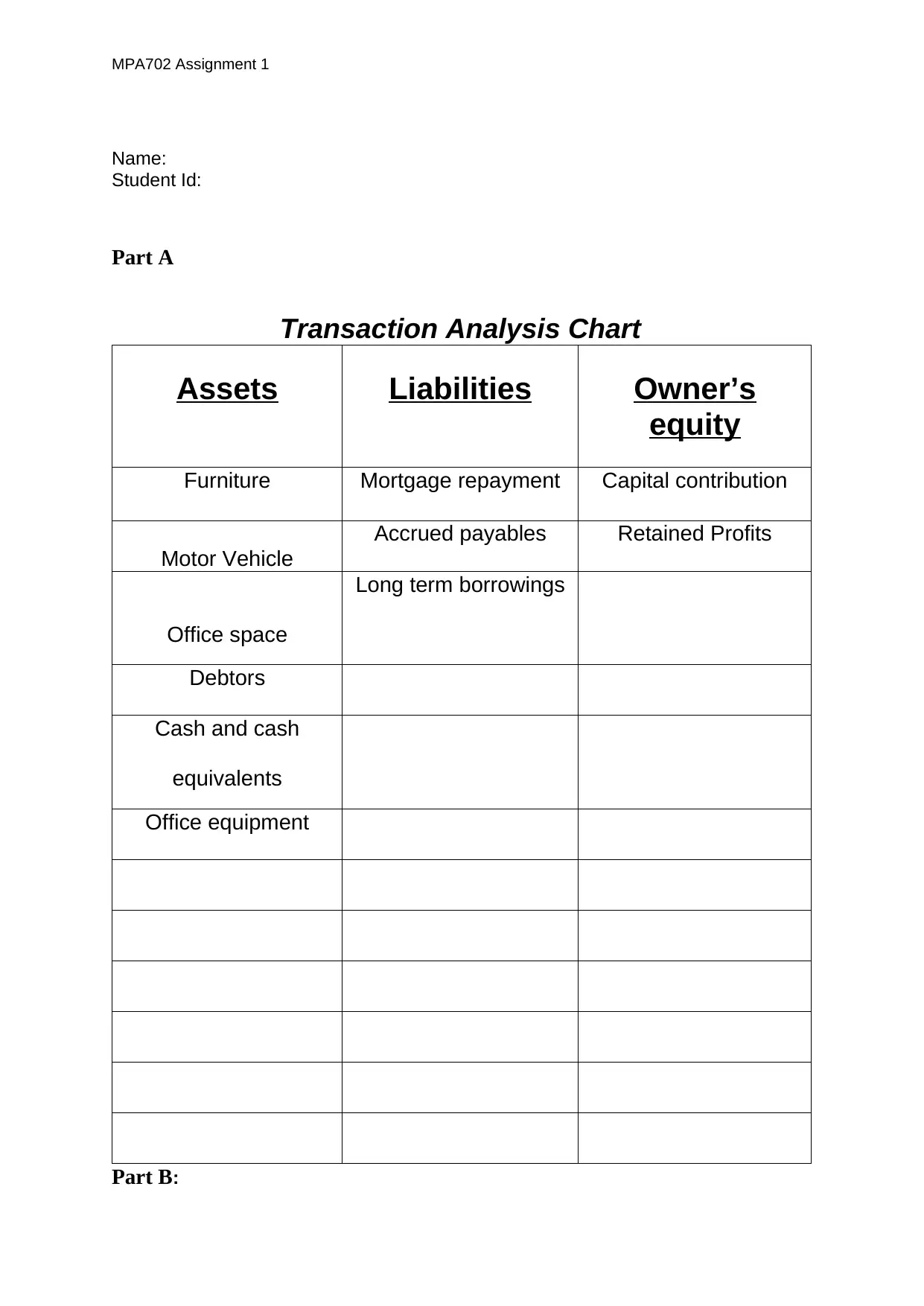
MPA702 Assignment 1
Name:
Student Id:
Part A
Transaction Analysis Chart
Assets Liabilities Owner’s
equity
Furniture Mortgage repayment Capital contribution
Motor Vehicle
Accrued payables Retained Profits
Office space
Long term borrowings
Debtors
Cash and cash
equivalents
Office equipment
Part B:
Name:
Student Id:
Part A
Transaction Analysis Chart
Assets Liabilities Owner’s
equity
Furniture Mortgage repayment Capital contribution
Motor Vehicle
Accrued payables Retained Profits
Office space
Long term borrowings
Debtors
Cash and cash
equivalents
Office equipment
Part B:
Paraphrase This Document
Need a fresh take? Get an instant paraphrase of this document with our AI Paraphraser
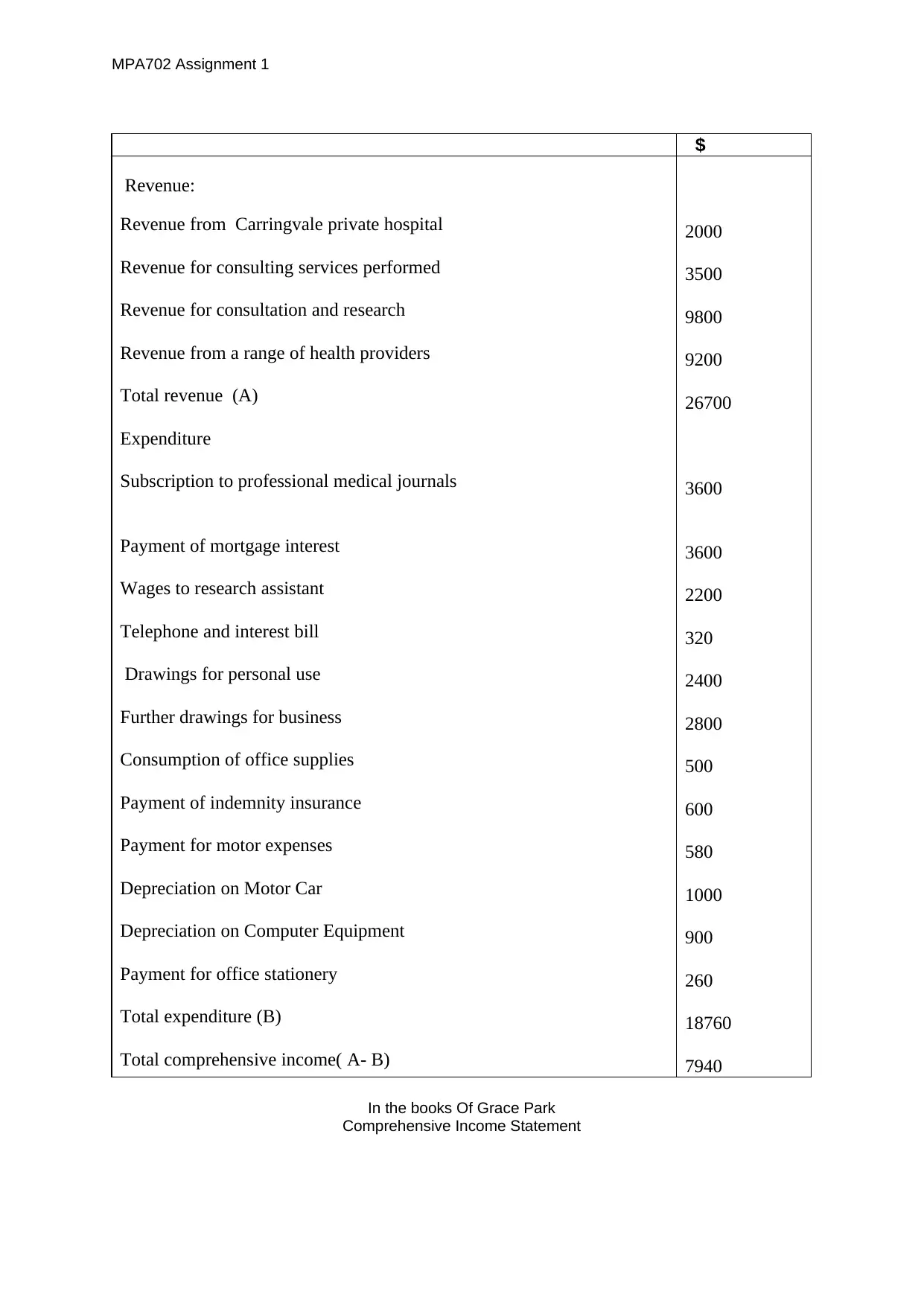
MPA702 Assignment 1
$
Revenue:
Revenue from Carringvale private hospital
Revenue for consulting services performed
Revenue for consultation and research
Revenue from a range of health providers
Total revenue (A)
Expenditure
Subscription to professional medical journals
Payment of mortgage interest
Wages to research assistant
Telephone and interest bill
Drawings for personal use
Further drawings for business
Consumption of office supplies
Payment of indemnity insurance
Payment for motor expenses
Depreciation on Motor Car
Depreciation on Computer Equipment
Payment for office stationery
Total expenditure (B)
Total comprehensive income( A- B)
2000
3500
9800
9200
26700
3600
3600
2200
320
2400
2800
500
600
580
1000
900
260
18760
7940
In the books Of Grace Park
Comprehensive Income Statement
$
Revenue:
Revenue from Carringvale private hospital
Revenue for consulting services performed
Revenue for consultation and research
Revenue from a range of health providers
Total revenue (A)
Expenditure
Subscription to professional medical journals
Payment of mortgage interest
Wages to research assistant
Telephone and interest bill
Drawings for personal use
Further drawings for business
Consumption of office supplies
Payment of indemnity insurance
Payment for motor expenses
Depreciation on Motor Car
Depreciation on Computer Equipment
Payment for office stationery
Total expenditure (B)
Total comprehensive income( A- B)
2000
3500
9800
9200
26700
3600
3600
2200
320
2400
2800
500
600
580
1000
900
260
18760
7940
In the books Of Grace Park
Comprehensive Income Statement
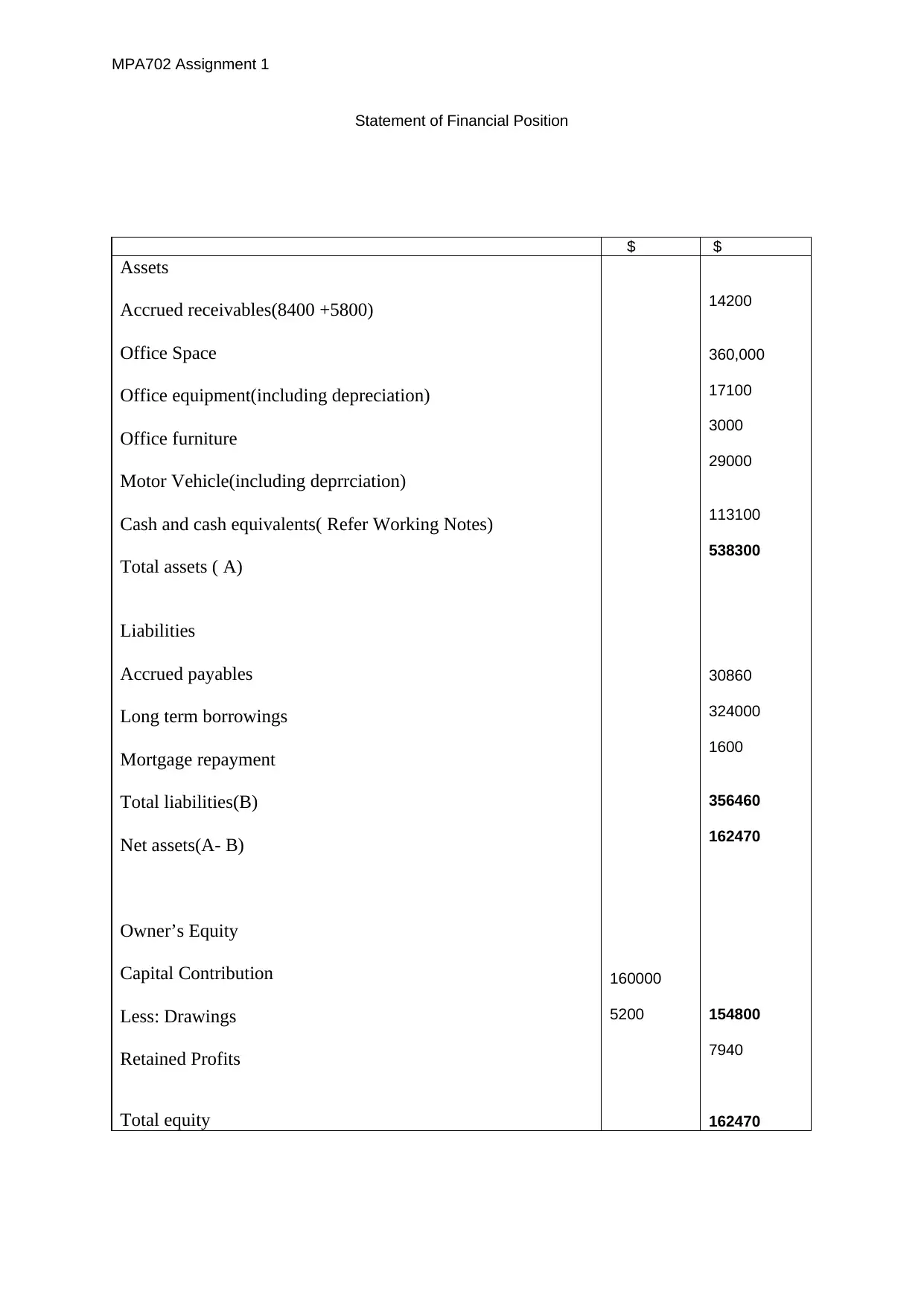
MPA702 Assignment 1
Statement of Financial Position
$ $
Assets
Accrued receivables(8400 +5800)
Office Space
Office equipment(including depreciation)
Office furniture
Motor Vehicle(including deprrciation)
Cash and cash equivalents( Refer Working Notes)
Total assets ( A)
Liabilities
Accrued payables
Long term borrowings
Mortgage repayment
Total liabilities(B)
Net assets(A- B)
Owner’s Equity
Capital Contribution
Less: Drawings
Retained Profits
Total equity
160000
5200
14200
360,000
17100
3000
29000
113100
538300
30860
324000
1600
356460
162470
154800
7940
162470
Statement of Financial Position
$ $
Assets
Accrued receivables(8400 +5800)
Office Space
Office equipment(including depreciation)
Office furniture
Motor Vehicle(including deprrciation)
Cash and cash equivalents( Refer Working Notes)
Total assets ( A)
Liabilities
Accrued payables
Long term borrowings
Mortgage repayment
Total liabilities(B)
Net assets(A- B)
Owner’s Equity
Capital Contribution
Less: Drawings
Retained Profits
Total equity
160000
5200
14200
360,000
17100
3000
29000
113100
538300
30860
324000
1600
356460
162470
154800
7940
162470
⊘ This is a preview!⊘
Do you want full access?
Subscribe today to unlock all pages.

Trusted by 1+ million students worldwide

MPA702 Assignment 1
Working notes-
Cash A/C
To Bal b/d
16000
0 By Office Equipment
1800
0
To Revenue 26700 BY medical journal 3600
By office furniture 3000
By insurance 600
By office space
3600
0
By drawings 5200
By telephone bill 320
By Interest 3600
By Wages 2200
BY office supplies 500
By motor vehicle
expenses 580
1,86,7
00 By balc/d
1131
00
Working notes-
Cash A/C
To Bal b/d
16000
0 By Office Equipment
1800
0
To Revenue 26700 BY medical journal 3600
By office furniture 3000
By insurance 600
By office space
3600
0
By drawings 5200
By telephone bill 320
By Interest 3600
By Wages 2200
BY office supplies 500
By motor vehicle
expenses 580
1,86,7
00 By balc/d
1131
00
Paraphrase This Document
Need a fresh take? Get an instant paraphrase of this document with our AI Paraphraser
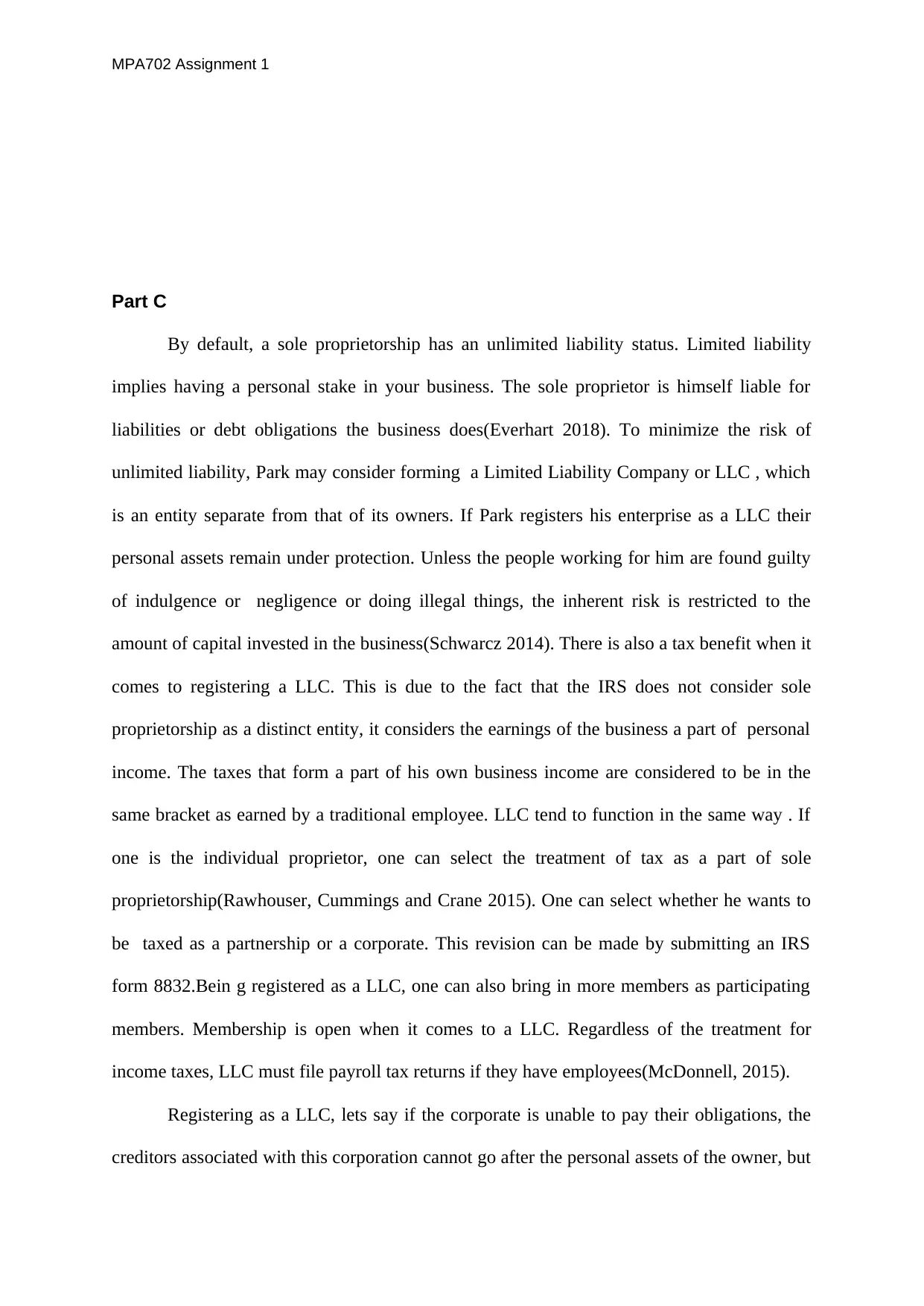
MPA702 Assignment 1
Part C
By default, a sole proprietorship has an unlimited liability status. Limited liability
implies having a personal stake in your business. The sole proprietor is himself liable for
liabilities or debt obligations the business does(Everhart 2018). To minimize the risk of
unlimited liability, Park may consider forming a Limited Liability Company or LLC , which
is an entity separate from that of its owners. If Park registers his enterprise as a LLC their
personal assets remain under protection. Unless the people working for him are found guilty
of indulgence or negligence or doing illegal things, the inherent risk is restricted to the
amount of capital invested in the business(Schwarcz 2014). There is also a tax benefit when it
comes to registering a LLC. This is due to the fact that the IRS does not consider sole
proprietorship as a distinct entity, it considers the earnings of the business a part of personal
income. The taxes that form a part of his own business income are considered to be in the
same bracket as earned by a traditional employee. LLC tend to function in the same way . If
one is the individual proprietor, one can select the treatment of tax as a part of sole
proprietorship(Rawhouser, Cummings and Crane 2015). One can select whether he wants to
be taxed as a partnership or a corporate. This revision can be made by submitting an IRS
form 8832.Bein g registered as a LLC, one can also bring in more members as participating
members. Membership is open when it comes to a LLC. Regardless of the treatment for
income taxes, LLC must file payroll tax returns if they have employees(McDonnell, 2015).
Registering as a LLC, lets say if the corporate is unable to pay their obligations, the
creditors associated with this corporation cannot go after the personal assets of the owner, but
Part C
By default, a sole proprietorship has an unlimited liability status. Limited liability
implies having a personal stake in your business. The sole proprietor is himself liable for
liabilities or debt obligations the business does(Everhart 2018). To minimize the risk of
unlimited liability, Park may consider forming a Limited Liability Company or LLC , which
is an entity separate from that of its owners. If Park registers his enterprise as a LLC their
personal assets remain under protection. Unless the people working for him are found guilty
of indulgence or negligence or doing illegal things, the inherent risk is restricted to the
amount of capital invested in the business(Schwarcz 2014). There is also a tax benefit when it
comes to registering a LLC. This is due to the fact that the IRS does not consider sole
proprietorship as a distinct entity, it considers the earnings of the business a part of personal
income. The taxes that form a part of his own business income are considered to be in the
same bracket as earned by a traditional employee. LLC tend to function in the same way . If
one is the individual proprietor, one can select the treatment of tax as a part of sole
proprietorship(Rawhouser, Cummings and Crane 2015). One can select whether he wants to
be taxed as a partnership or a corporate. This revision can be made by submitting an IRS
form 8832.Bein g registered as a LLC, one can also bring in more members as participating
members. Membership is open when it comes to a LLC. Regardless of the treatment for
income taxes, LLC must file payroll tax returns if they have employees(McDonnell, 2015).
Registering as a LLC, lets say if the corporate is unable to pay their obligations, the
creditors associated with this corporation cannot go after the personal assets of the owner, but
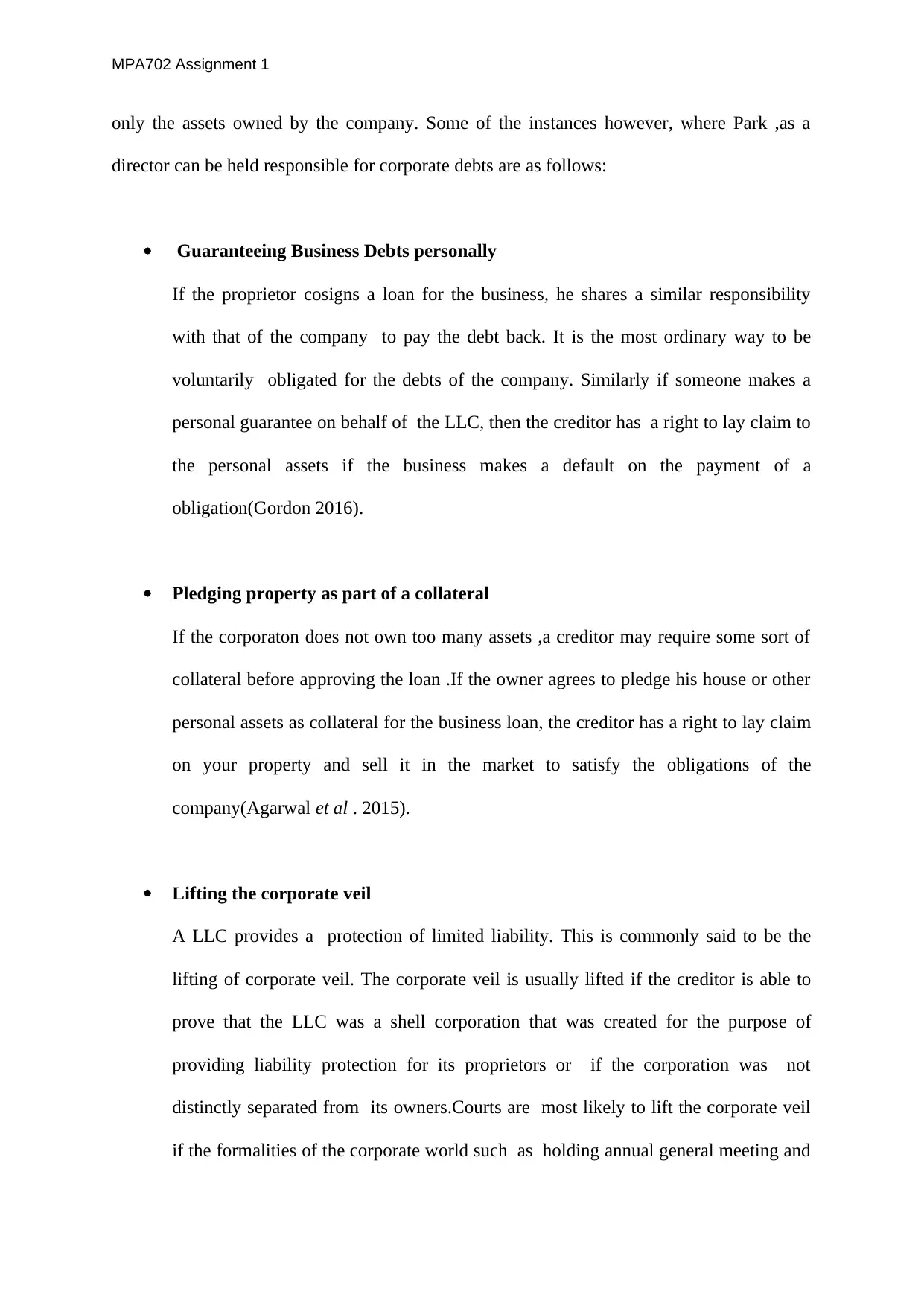
MPA702 Assignment 1
only the assets owned by the company. Some of the instances however, where Park ,as a
director can be held responsible for corporate debts are as follows:
Guaranteeing Business Debts personally
If the proprietor cosigns a loan for the business, he shares a similar responsibility
with that of the company to pay the debt back. It is the most ordinary way to be
voluntarily obligated for the debts of the company. Similarly if someone makes a
personal guarantee on behalf of the LLC, then the creditor has a right to lay claim to
the personal assets if the business makes a default on the payment of a
obligation(Gordon 2016).
Pledging property as part of a collateral
If the corporaton does not own too many assets ,a creditor may require some sort of
collateral before approving the loan .If the owner agrees to pledge his house or other
personal assets as collateral for the business loan, the creditor has a right to lay claim
on your property and sell it in the market to satisfy the obligations of the
company(Agarwal et al . 2015).
Lifting the corporate veil
A LLC provides a protection of limited liability. This is commonly said to be the
lifting of corporate veil. The corporate veil is usually lifted if the creditor is able to
prove that the LLC was a shell corporation that was created for the purpose of
providing liability protection for its proprietors or if the corporation was not
distinctly separated from its owners.Courts are most likely to lift the corporate veil
if the formalities of the corporate world such as holding annual general meeting and
only the assets owned by the company. Some of the instances however, where Park ,as a
director can be held responsible for corporate debts are as follows:
Guaranteeing Business Debts personally
If the proprietor cosigns a loan for the business, he shares a similar responsibility
with that of the company to pay the debt back. It is the most ordinary way to be
voluntarily obligated for the debts of the company. Similarly if someone makes a
personal guarantee on behalf of the LLC, then the creditor has a right to lay claim to
the personal assets if the business makes a default on the payment of a
obligation(Gordon 2016).
Pledging property as part of a collateral
If the corporaton does not own too many assets ,a creditor may require some sort of
collateral before approving the loan .If the owner agrees to pledge his house or other
personal assets as collateral for the business loan, the creditor has a right to lay claim
on your property and sell it in the market to satisfy the obligations of the
company(Agarwal et al . 2015).
Lifting the corporate veil
A LLC provides a protection of limited liability. This is commonly said to be the
lifting of corporate veil. The corporate veil is usually lifted if the creditor is able to
prove that the LLC was a shell corporation that was created for the purpose of
providing liability protection for its proprietors or if the corporation was not
distinctly separated from its owners.Courts are most likely to lift the corporate veil
if the formalities of the corporate world such as holding annual general meeting and
⊘ This is a preview!⊘
Do you want full access?
Subscribe today to unlock all pages.

Trusted by 1+ million students worldwide
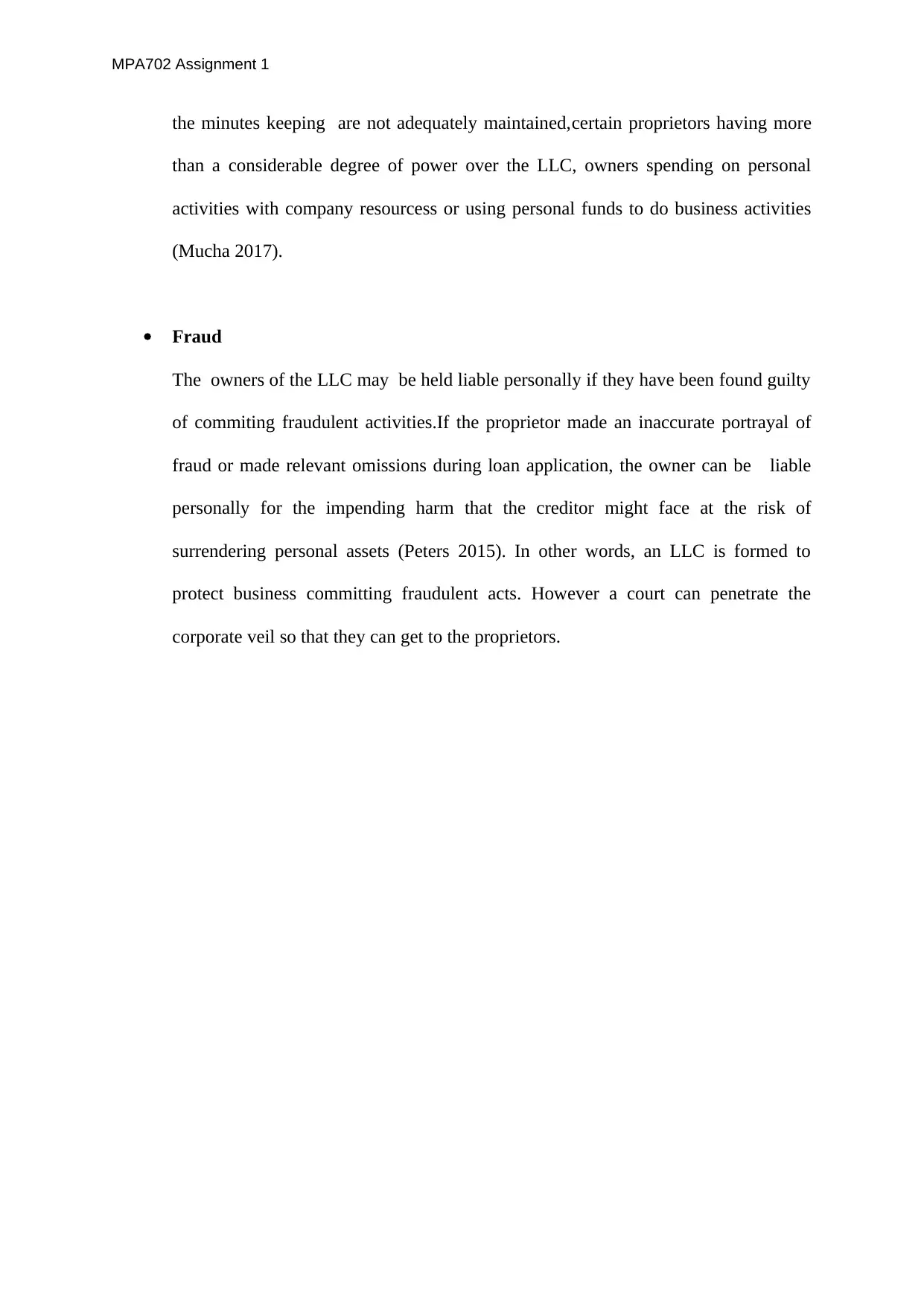
MPA702 Assignment 1
the minutes keeping are not adequately maintained,certain proprietors having more
than a considerable degree of power over the LLC, owners spending on personal
activities with company resourcess or using personal funds to do business activities
(Mucha 2017).
Fraud
The owners of the LLC may be held liable personally if they have been found guilty
of commiting fraudulent activities.If the proprietor made an inaccurate portrayal of
fraud or made relevant omissions during loan application, the owner can be liable
personally for the impending harm that the creditor might face at the risk of
surrendering personal assets (Peters 2015). In other words, an LLC is formed to
protect business committing fraudulent acts. However a court can penetrate the
corporate veil so that they can get to the proprietors.
the minutes keeping are not adequately maintained,certain proprietors having more
than a considerable degree of power over the LLC, owners spending on personal
activities with company resourcess or using personal funds to do business activities
(Mucha 2017).
Fraud
The owners of the LLC may be held liable personally if they have been found guilty
of commiting fraudulent activities.If the proprietor made an inaccurate portrayal of
fraud or made relevant omissions during loan application, the owner can be liable
personally for the impending harm that the creditor might face at the risk of
surrendering personal assets (Peters 2015). In other words, an LLC is formed to
protect business committing fraudulent acts. However a court can penetrate the
corporate veil so that they can get to the proprietors.
Paraphrase This Document
Need a fresh take? Get an instant paraphrase of this document with our AI Paraphraser
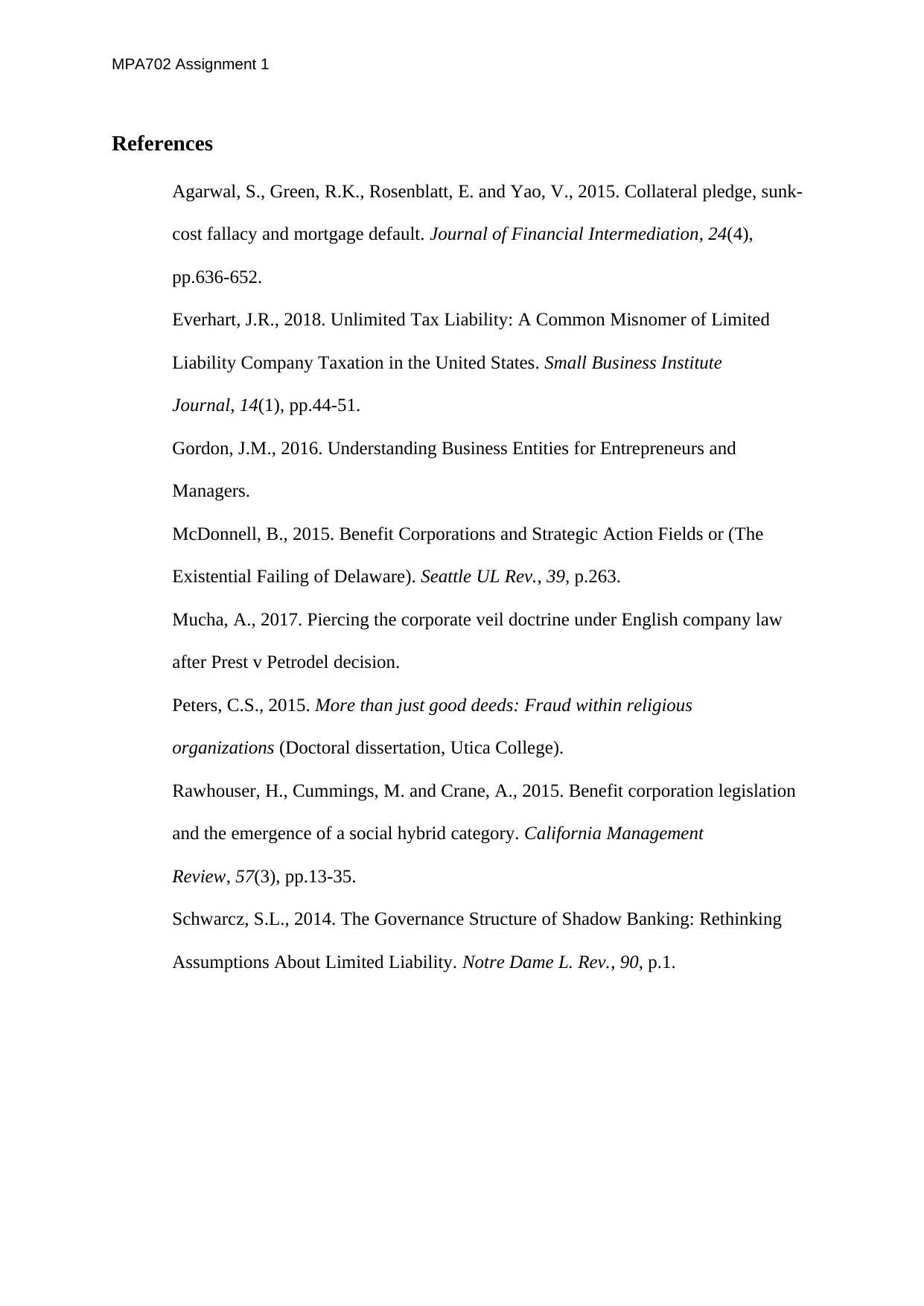
MPA702 Assignment 1
References
Agarwal, S., Green, R.K., Rosenblatt, E. and Yao, V., 2015. Collateral pledge, sunk-
cost fallacy and mortgage default. Journal of Financial Intermediation, 24(4),
pp.636-652.
Everhart, J.R., 2018. Unlimited Tax Liability: A Common Misnomer of Limited
Liability Company Taxation in the United States. Small Business Institute
Journal, 14(1), pp.44-51.
Gordon, J.M., 2016. Understanding Business Entities for Entrepreneurs and
Managers.
McDonnell, B., 2015. Benefit Corporations and Strategic Action Fields or (The
Existential Failing of Delaware). Seattle UL Rev., 39, p.263.
Mucha, A., 2017. Piercing the corporate veil doctrine under English company law
after Prest v Petrodel decision.
Peters, C.S., 2015. More than just good deeds: Fraud within religious
organizations (Doctoral dissertation, Utica College).
Rawhouser, H., Cummings, M. and Crane, A., 2015. Benefit corporation legislation
and the emergence of a social hybrid category. California Management
Review, 57(3), pp.13-35.
Schwarcz, S.L., 2014. The Governance Structure of Shadow Banking: Rethinking
Assumptions About Limited Liability. Notre Dame L. Rev., 90, p.1.
References
Agarwal, S., Green, R.K., Rosenblatt, E. and Yao, V., 2015. Collateral pledge, sunk-
cost fallacy and mortgage default. Journal of Financial Intermediation, 24(4),
pp.636-652.
Everhart, J.R., 2018. Unlimited Tax Liability: A Common Misnomer of Limited
Liability Company Taxation in the United States. Small Business Institute
Journal, 14(1), pp.44-51.
Gordon, J.M., 2016. Understanding Business Entities for Entrepreneurs and
Managers.
McDonnell, B., 2015. Benefit Corporations and Strategic Action Fields or (The
Existential Failing of Delaware). Seattle UL Rev., 39, p.263.
Mucha, A., 2017. Piercing the corporate veil doctrine under English company law
after Prest v Petrodel decision.
Peters, C.S., 2015. More than just good deeds: Fraud within religious
organizations (Doctoral dissertation, Utica College).
Rawhouser, H., Cummings, M. and Crane, A., 2015. Benefit corporation legislation
and the emergence of a social hybrid category. California Management
Review, 57(3), pp.13-35.
Schwarcz, S.L., 2014. The Governance Structure of Shadow Banking: Rethinking
Assumptions About Limited Liability. Notre Dame L. Rev., 90, p.1.
1 out of 8
Related Documents
Your All-in-One AI-Powered Toolkit for Academic Success.
+13062052269
info@desklib.com
Available 24*7 on WhatsApp / Email
![[object Object]](/_next/static/media/star-bottom.7253800d.svg)
Unlock your academic potential
Copyright © 2020–2025 A2Z Services. All Rights Reserved. Developed and managed by ZUCOL.



